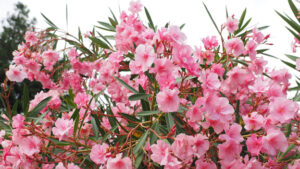
Naturalised plants
By Clive Larkman
My wife Di and I and a good friend were invited to a birthday celebration for two friends. One was turning 50 and the other 40! The catch was the party was happening on the island of Vulcano of the coast of Sicily. It is one of the seven Aeolian Islands, all of which are old volcanoes. Vulcano is the youngest, dating back around 3000 BC. It is also the island that is responsible for the word ‘volcano’ as it was believed by the Romans that it was the chimney for the God Vulcan’s foundry. They named the island Vulcano and so arose the word volcano.
We arrived by boat from Palermo and the first thing we noticed, after the steaming volcano, was the powerful colour of the oleanders and geraniums. Being good plants folk, we proceeded to look at the plants growing around the villa. There were many magnificent succulents, strelitzia, palms, and a range of dry tolerant plants, not surprising considering we were in an area surrounding the Mediterranean Sea. It was very hot and extremely dry, conditions to which the above plants are very well suited.
The following day we took a ‘taxi driver’ tour of the island. The driver’s name was Sante and he knew a lot about his home and had a great understanding of volcanic activity, plate tectonics, and basic botany. He knew that the majority of the plants growing across the island, in both wild and domesticated areas, were introduced weeds. There are a couple of areas (which we could not visit) that still have remnant indigenous plants like Arbutos unedo, Cistus creticus, Capparis spinosa, Cytisus aeolicus, Silene hicesiae, and Bassia saxicola. There was a range of other shrubs and sub-shrubs but what was very obvious, was the strength of the alien plant populations.
Alien or invasive plants are of concern across the world and every country is responsible for their own plants being weeds in another country, and for having many plants that have escaped the farming or ornamental sectors. The big difference is in how badly the wild bush has been invaded. In Australia we are fortunate that few plants have established to the level where the bush is permanently and extensively changed. Most parkland is able to be recovered (sometimes with significant funds and resources) however what we saw in Vulcano was beyond resurrection.
The degree to which the foreign plants have established themselves was quite profound. Without listing all the alien invaders, as that would be a full-bodied research project on its own, I can note some of the main ones. There were four main plants in the public land around the township; these were Eucalyptus cladocalyx, Acacia iteaphylla, Opuntia ficus–indica and Nerium oleander. They were widespread across the island and added colour, form and a stable plant environment. There were many others like bougainvillea, palms, metrosideros, mesembryanthemum, andpelargonium that were becoming more invasive. There was also a range of plants that were not endemic to Vulcano, but that have arrived from neighbouring regions and were establishing themselves. Given the harsh, dry conditions and poor soil it is no wonder that plants, which have been introduced from other regions with similar conditions, are dominating the landscape.
As an evolutionary botanist I find this a fascinating scenario. The land is poor, the climate harsh, and the endemic plants are neither strong nor widespread. Some of the weeds have been introduced intentionally to help give greenlife to the built environment, and some just because they survive well. Most of these introduced plants are colonising areas of old second-stage plants that love these conditions, but which struggle to compete with strong growers, such as weeds, for resources.
The classic scenario in plant succession is that ‘colonisers’ arrive on bare or new ground and set seed. They need lots of light and little else to grow, but grow slowly. After several generations they will have changed the substrate and added significant organic matter and nutrients to the soil. This allows seeds of stage-two plants to germinate. These plants require better soil and full sun, but are quick growers. They quickly out-grow the primary colonisers and remove their access to direct sun. The colonisers are now at a disadvantage and quickly die out.
This is the theory and has been observed in many cases, and is an accepted theory. What is happening on Vulcano is an extreme case, and it would be fascinating to go back every three years and document changes in the plant make up, the organic matter in the soil, and the overall fertility of the areas that were dominated by the alien invaders. The next step would be to compare the genetics of the established plants, with those of the plants in the countries where they originated, and at the same time, look for new intergeneric and interspecific hybrids that have evolved to deal with the harsh volcanic environment.
I suspect that in 100 years we will find a range of plants that are very different from their parents, and which includes many new species.
